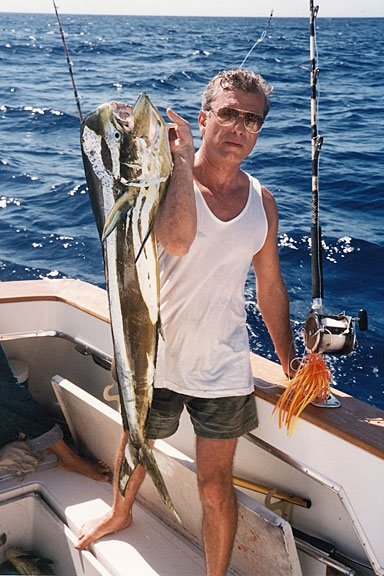
A CRITIC REMINISCES
When you are talking seriously about theater, it’s bad form to get physical.
You just have to ignore that if the discussion is about Steven Mastroieni. The guy has presence and there’s no escaping it.
Charisma? Sure, that old standby is part of it. But a hefty portion of his appeal is the look, darkly leonine with thick, curly hair that clusters around his head in a raven mass. He radiates masculinity and strength of character.
That makes him a good lover on stage. And a hell of a villain.
My wife says I shouldn’t forget his eyes. She calls them “bedroom eyes.” I won’t get into that. I will say they can be smouldering. Or piercing. They serve as an open window to his emotions, revealing the mood clearly to watchers in the back row. Yeah. Nice eyes.
Steve was a major draw when I made it into town. He remained so in the succeeding years. He was good at comedy, but it was the dramas that drew the crowds. People told me “You should have seen him in Wait Until Dark (before my time). Apparently he was really bad. As in evil bad. I liked him best in Whose Life Is It Anyway? (after my arrival), He was really good. He played a man who was paralyzed. His performance was from the neck up. He blew me away.
Now that’s acting!
Another favorite was The Night of the Iguana. He had the Richard Burton role of the defrocked priest. He didn’t look anything like Liz’ Dick but he had the world-weary drunken-poet bit down perfectly.
Then there was Orphans. He was a gangster who attracted the attention of two dangerous young men in search of a father figure. Audiences at Actors Theatre of Phoenix were ecstatic. Critics were a little giddy, too.
Like most who rise to the top ranks of the acting profession (discounting those who get there on their looks), Steve really can’t be compared to anyone but himself. On stage, and off, he was, and is, his own man.
It’s just what Phoenix theater needed then – and needs today. — Kyle Lawson.
SOMETIMES FATHER REALLY DOES KNOW BEST
Steven earned critical praise for his portrayal of a 1880s doctor who thwarts his plain-jane daughter’s attempts to marry a handsome fortune hunter.
“Mastroieni doesn’t play a stock villain. He makes his Austin terrifically complex. When it all hits the fan, we get a glimmer of tenderness and concern. Austin’s instincts about Morris are right and every parent in the audience roots for dad even while despising him.” — Michelle Hoffman, Arizona Republic, March 5, 2015.
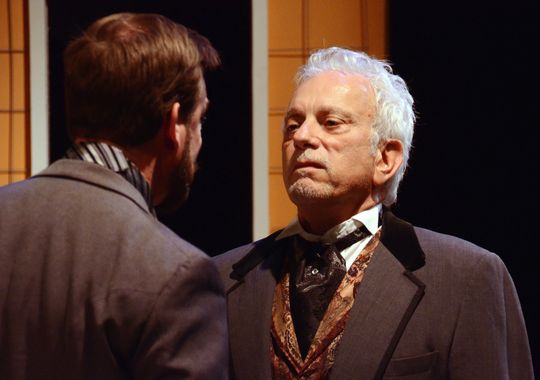
ACTING SOMETIMES DEMANDS MORE THAN TALENT, IT REQUIRES COURAGE
When Steven appeared in the first overtly gay-themed production to make it to a Valley stage (1978’s The Boys in the Band at Scottsdale Community Players), he did more than associate himself with a landmark in local theater history, he took a serious risk.
He was a popular leading man, specializing in staunchly masculine roles. To play a gay in a period when gay men were kept in the closet by the public (whether they were out or not) was to put his image to the test. Moreover, there were threatening phone calls, pickets at the theater, rumors of a bomb, nasty letters in the paper … it took courage.
That he accepted the role, that he played it so well, that he didn’t flinch in the face of the threats and the criticism – it is one of the reasons this man will always be one of my theater idols.
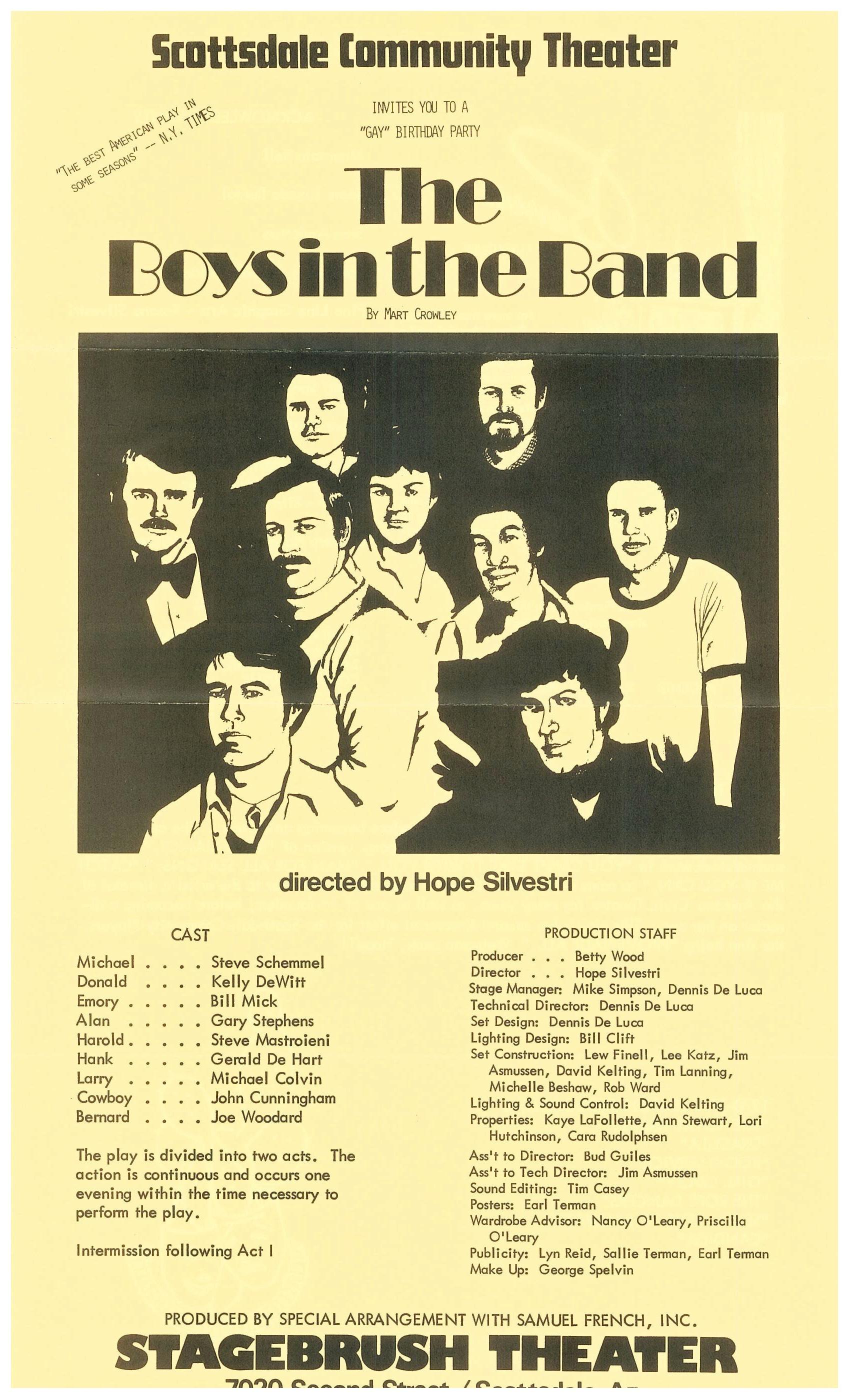
*****
STRANGERS ON A TRAIN – OR ARE THEY?
2012. The Unexpected Man. Theatre Artists Studio. Directed by Carol MacLeod. Named one of 10 best plays of 2012 by the Arizona Republic.
Yasmina Reza’s The Unexpected Man, written in 1995, presents audiences with a man and a woman sitting across from each other in a train compartment. Will they speak to each other? Steven and Drea Pruseau generated quite a bit of tension in answer to this simple question.
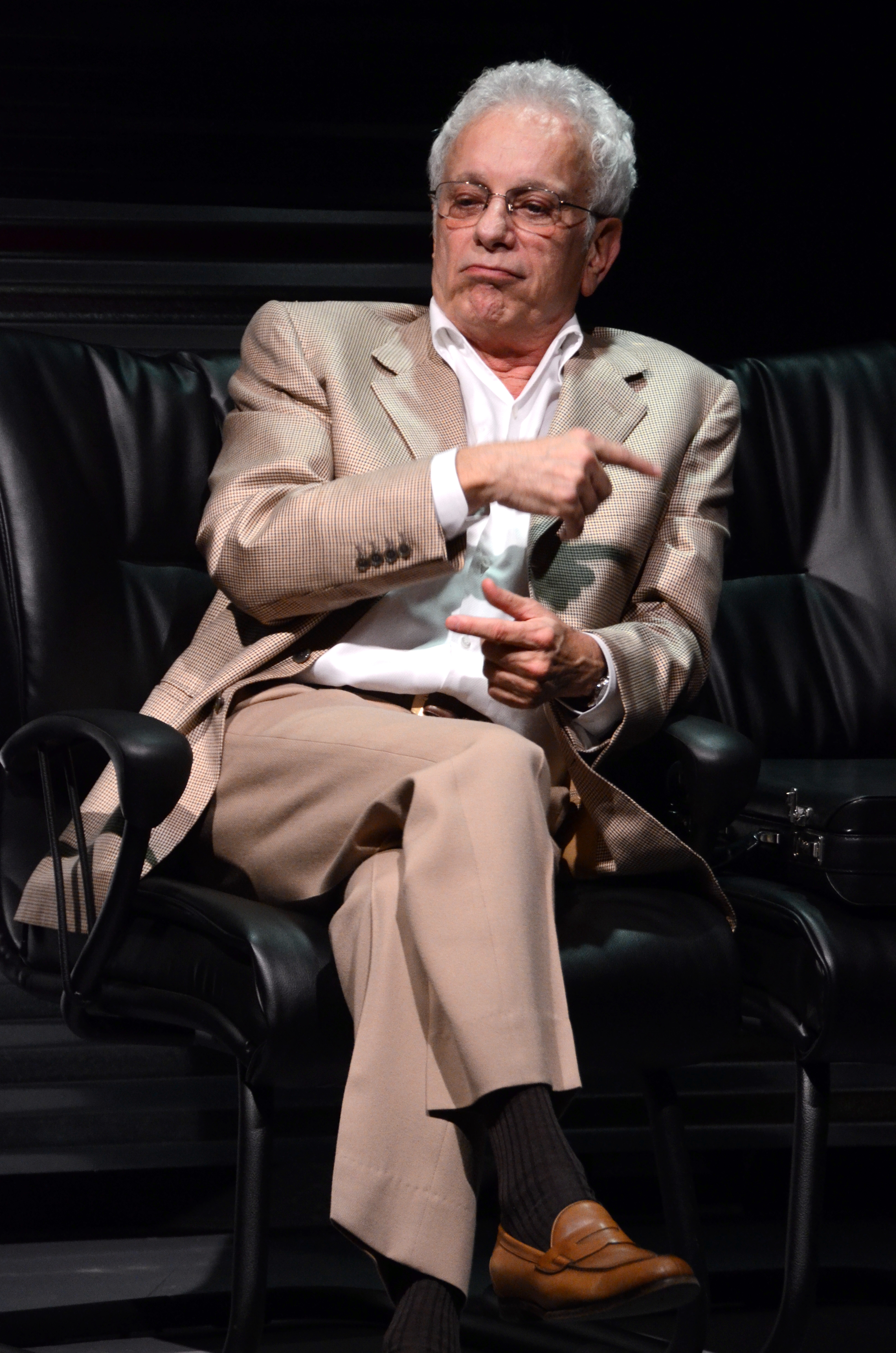
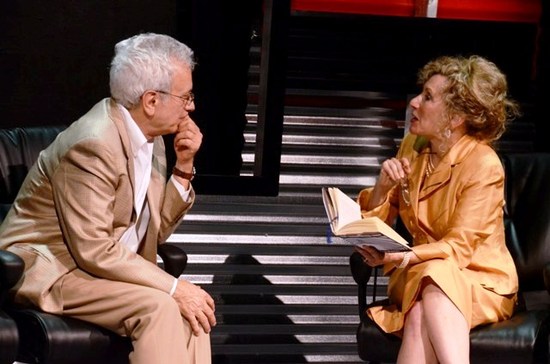
CUTTING EDGE DRAMA
Steven remembers an incident from 1969’s production of Wait Until Dark at Phoenix Little Theatre. This thriller is always a potent audience pleaser and PLT’s production was no exception – though, one night, audiences got more than they bargained for.
“The first show I did on the Main Stage at PLT was with Jacqueline Gaston as a blind housewife to my vicious Roat. I cut Jacque’s forearm in the black-out scene at the end of the play. We struggled outside of prearranged blocking and I had a really sharp gravity knife. I didn’t realize I had cut her until pinning her against the open refrigerator door – red on white. She swooned at curtain call.” — Steven Mastroieni.
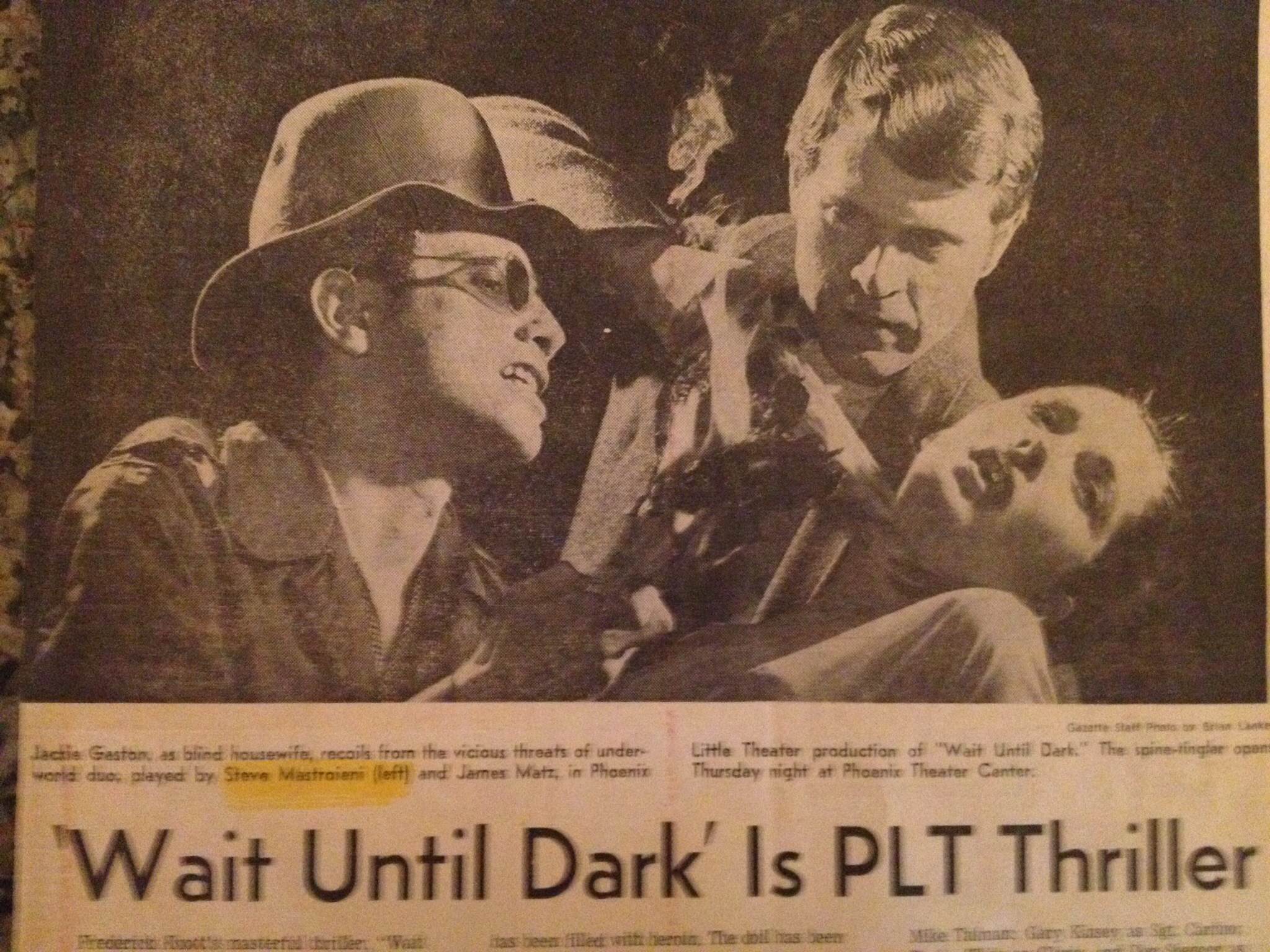
*****
IT’S ALL IN THE FACE
November 1981, “Whose Life Is It, Anyway?”, Phoenix Little Theatre
Over its long history, Phoenix Theatre has undergone several Renaissances. One was in the late 1970s-early 1980s, when, under the direction of Tom Oldendick, it forged a reputation for presenting the finest scripts from New York, London and the great classics. One of the more critically acclaimed productions was Whose Life Is It Anyway?, Brian Clark’s comedy-drama which opened in London in 1978 and New York in 1979. Phoenix Little Theatre brought it to the Valley two years later. Steven played Ken Harrison, a sculptor by profession, who is paralyzed from the neck down (quadriplegia) after a car accident and is determined to be allowed to die. Using only his face to register emotion, Steven created an unforgettable character.
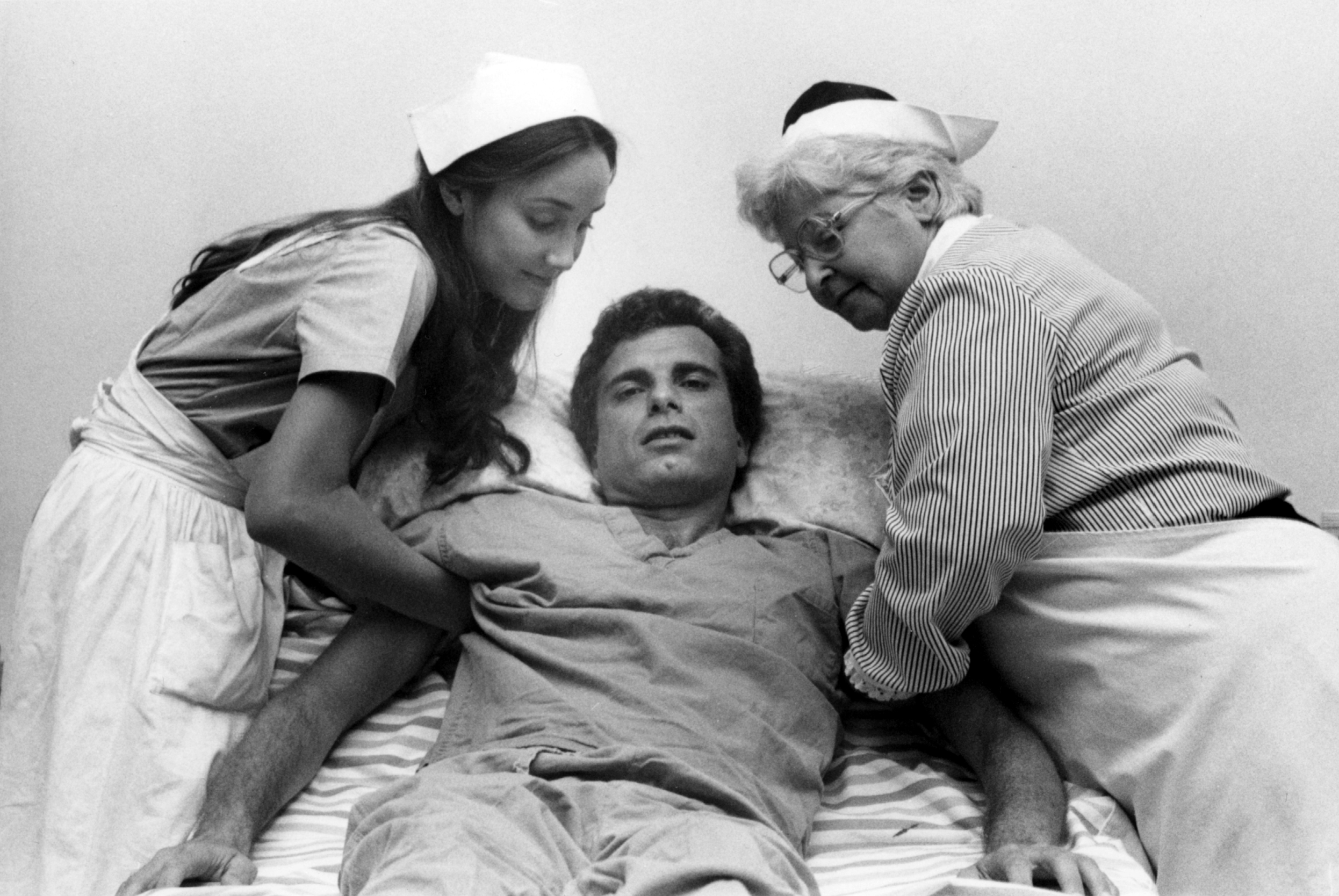
*****
STEAMY MEXICAN NIGHTS
I never knew Ruth Willis to deliver less than a home run when she stood up to bat. Her steamy, hard-edged production of the Tennessee Williams drama, The Night of the Iguana, produced at Phoenix Little Theatre in 1981, was no exception. She drew strong performances from every member of her cast, but none more so than those of Steven and Carolyn Pain. Steven’s dark looks and rumbling voice added a layer of appeal to his dissolute, defrocked priest, while Carolyn went totally against type to give us a wonderfully blowsy innkeeper. Like all theater, you had to be there to experience it to the fullest. Really, you should have been.
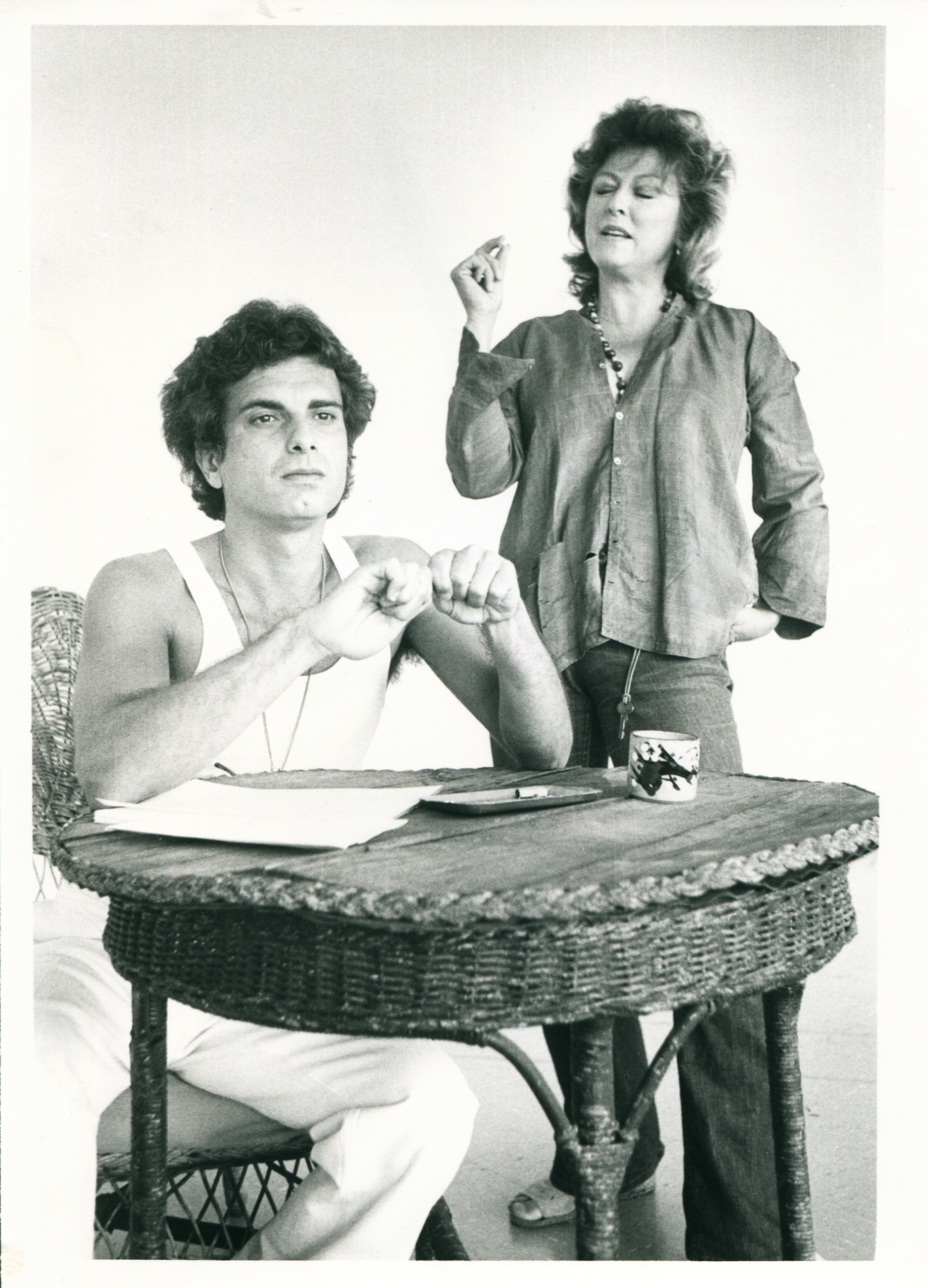
*****
CREATING HISTORY
This photograph, taken to publicize 1979’s production of No Exit at Phoenix Little Theatre, is historically significant for several reasons. For one, the plays of Jean-Paul Sartre have seldom been produced in Phoenix. Another is that it is representative of the kind of work done at Phoenix Theatre (then Phoenix Little Theatre) in the mid- to late ’70s. Theatre One was a tiny stage located literally in the rafters of the theater. You had to climb to get there, the seats weren’t very comfortable, but the fare was exceptional. The best people worked there. No Exit was proof of that, with its direction by the legendary Ruth Willis and a cast that included Steven, one of the era’s most in-demand leading men, and Paty Lombard, one of its most fascinating and beautiful actresses.
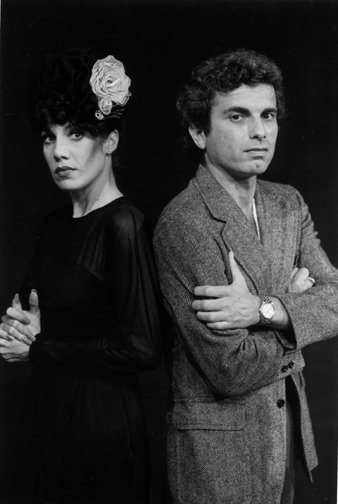
*****
ATTACK OF THE LIZARD PEOPLE
One of the more unusual productions at Phoenix Little Theatre in the 1970s was the 1978 rendition of Edward Albee’s Pulitzer Prize-winning Seascape. A couple on the verge of retirement find themselves discussing their relationship problems with a lizard couple who have emerged from the sea feeling that they are so evolved they must now live on land. It’s a combination of drama and comedy with a definite absurdist twinge. Steve had the part of the lizard man that won Frank Langella a Tony Award when he played it on Broadway.
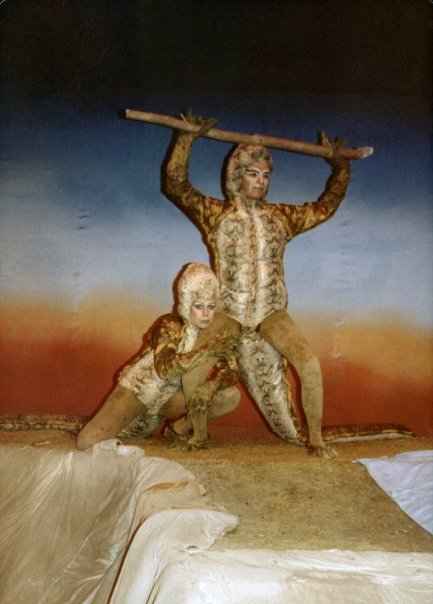
*****
ARC SPOTS IN THE SKY: A WORLD PREMIERE
In March of 1975, Scottsdale Community Players presented the world premiere of Tim Kelly’s Frankenstein at the Stagebrush Theatre. Kelly with a prolific playwright, with more than 50 titles to his credit by this time. The cast included Thomas Mastronardi as Dr. Frankenstein, Steven Mastroieni as Henry Clerval, Thomas Blackwood as ‘The Creature,’ Joan Silberschlag as Frau Frankenstein, Gene Smith, Fay Bullock and Royce Bauder. Ken Kloth designed the sets.
Steven Mastroieni remembers … “Tim had worked in the Valley with Scottsdale Community Players before and he also worked as the theatre critic for the Arizona Republic and as theatre editor for Point West Magazine. He was a ‘fellow’ at Yale University for a year.
This was the first time Frankenstein had been preformed.
The original book by Mary Shelly was extremely florid, rich and rococo. This was difficult to translate into a viable stage version, according to Tim.
Tim said he considered Scottsdale home and he had a special fondness for the Stagebrush and Scottsdale Community Players, and that it was a luxury to take time off from filming to come back for five weeks to put Frankenstein ‘up’.
It was very exciting for me, a young actor to have the experience of working with the writer as director and being in a premiere. The show was both a critical hit and an audience favorite. Performances sold out.”

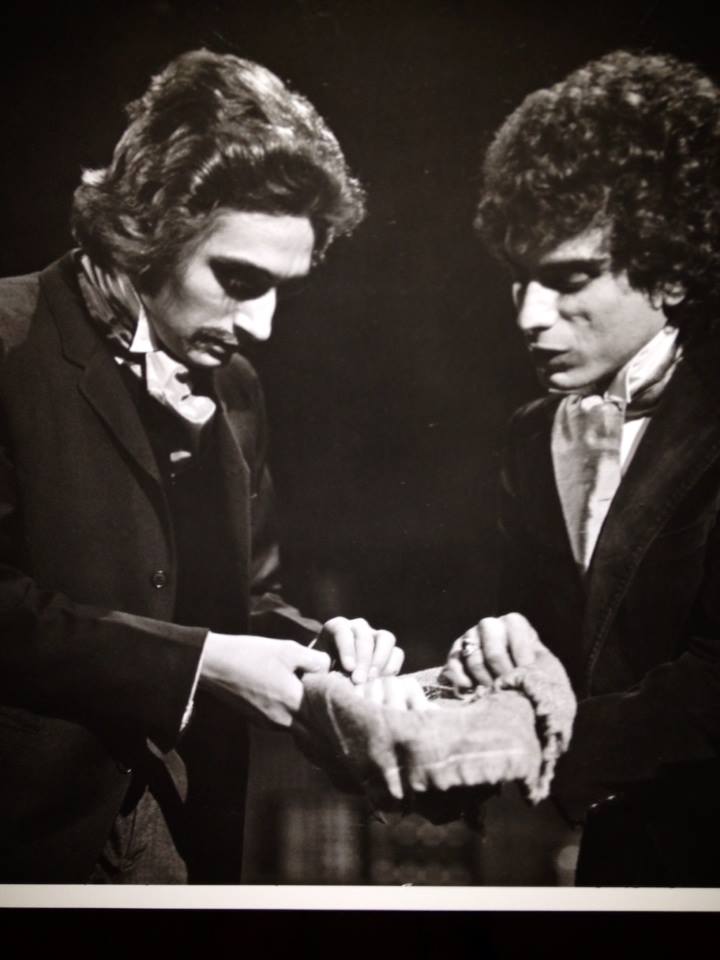
*****
CROWNING THE ‘KING’
Steve appeared in many plays that received good reviews, but they were seldom as wonderful as the one penned by Marshall W. Mason in the New Times for Exit the King (1995) at In Mixed Company. (For Marshall’s review, go HERE.) It isn’t just a review of the play, it’s a history lesson on theater. Wonderful. As for Steven, Marshall wrote ” Best of all is Steven Mastroieni as the King. His performance focuses on the journey from arrogance to acceptance with a keen economy.”
Awarded the New Times Best Production of 1995. Steve won the Tribune Newspapers’ Maxie Award for Best Actor in a Drama.
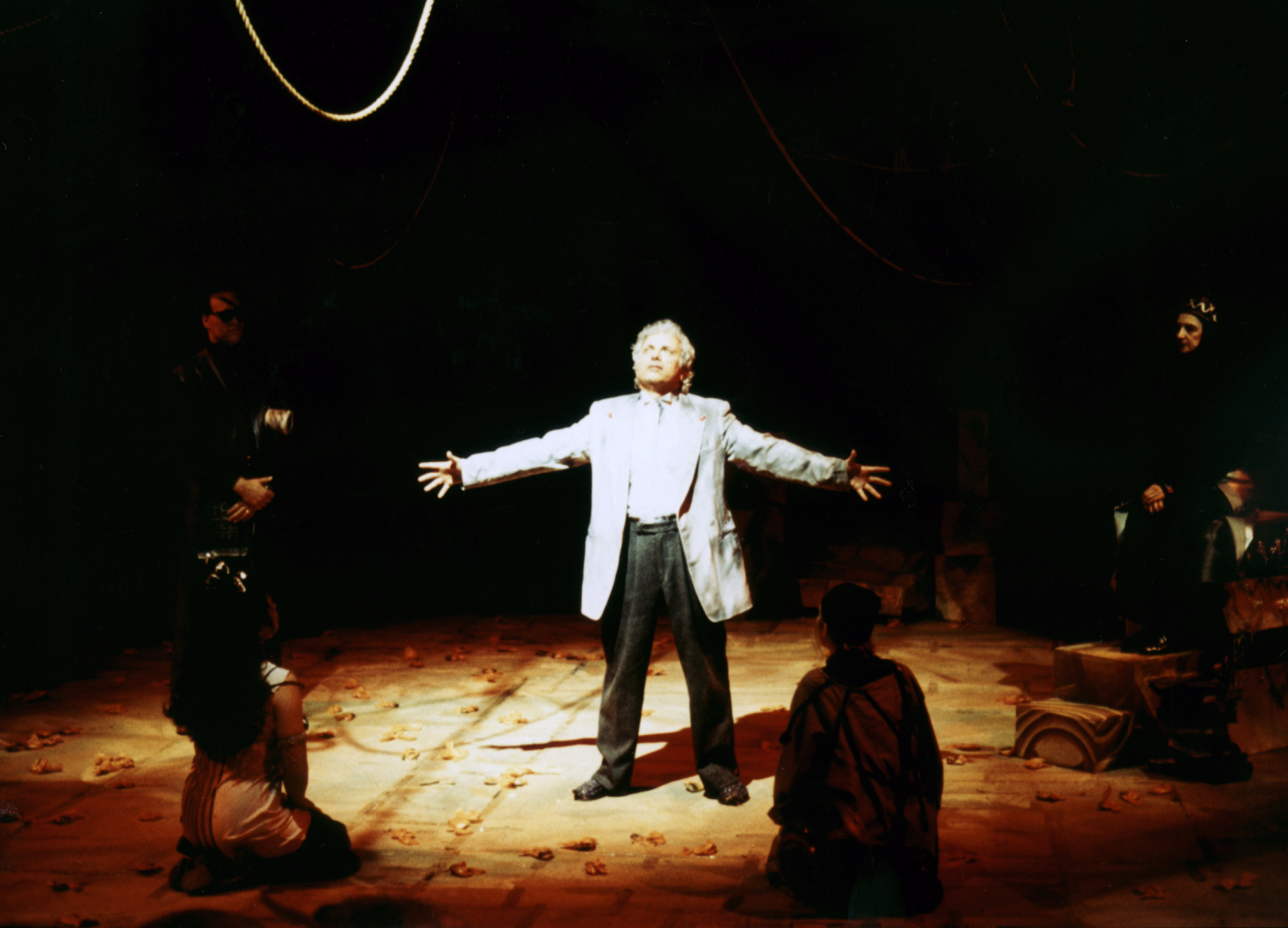
1+1 = WOW!
More rave reviews came Steven’s way for his work in the ASU Showcase Series revival of Elmer Rice’s 1923 masterpiece, The Adding Machine. It wasn’t quite as popular as Exit the King, but then 1994 audiences weren’t as attuned to art that was highly subjective and nonrealistic unless Samuel Beckett’s name was attached. The play centered on the trial, execution and journey to the afterlife of an accountant who killed his boss. The Sound of Music it wasn’t.
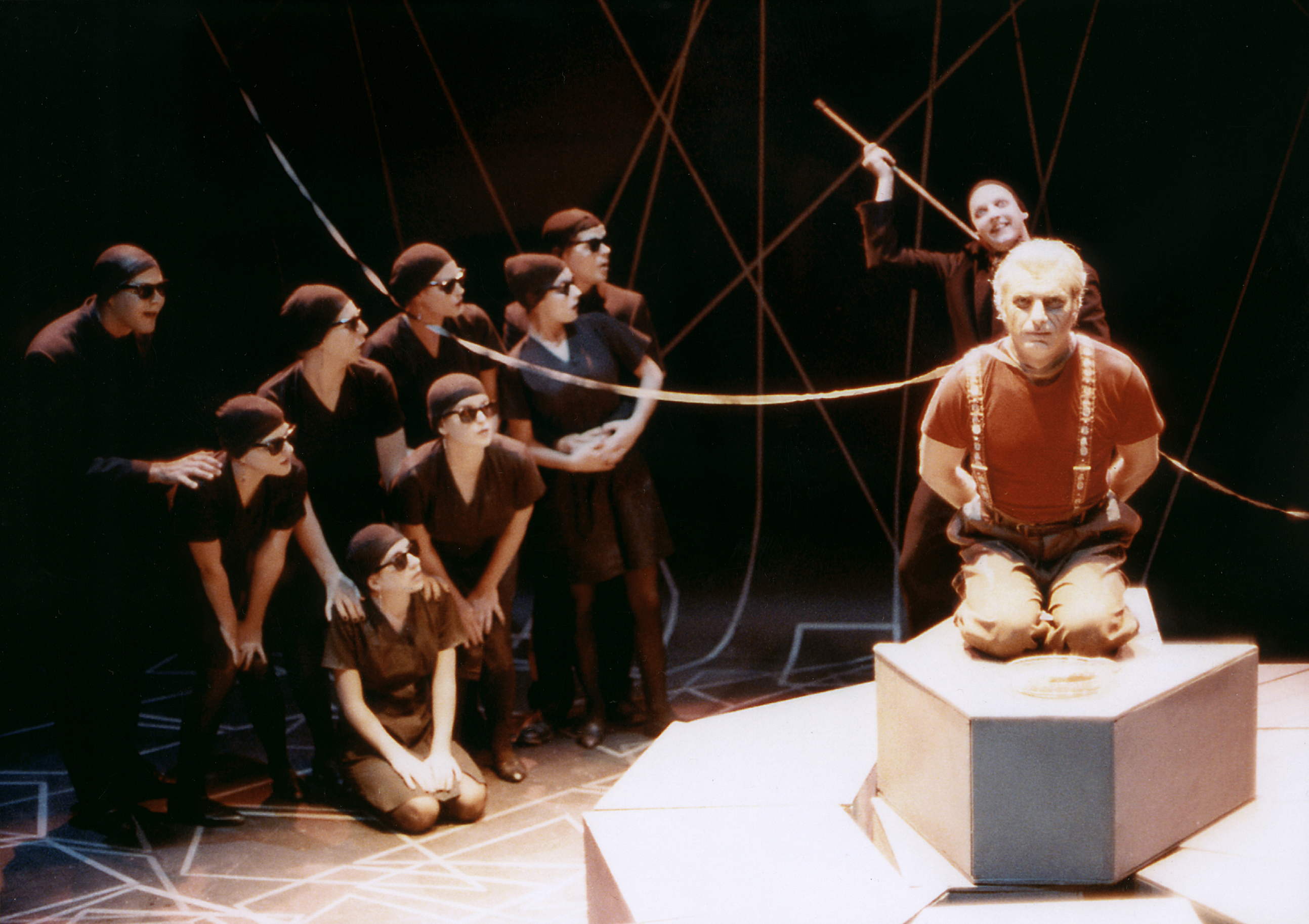
*****
- For Steven’s work with Actors Theatre/Actors Theatre of Phoenix, go HERE
- For Steven’s work with Phoenix Theatre/Phoenix Little Theatre, go HERE
- To find other references to Steven, type his name in the search box at left.
- Steve studied at the Royal Academy of Dramatic Arts and the Drama Studio, London at Berkley.
- Steve has a bachelor’s degree in theater from Arizona State University.
- Steve has a gift for accents, including Italian, Cockney, Harley Street and various regional American dialects.
*****
PHOTOGRAPHS, REVIEWS & THE KITCHEN SINK
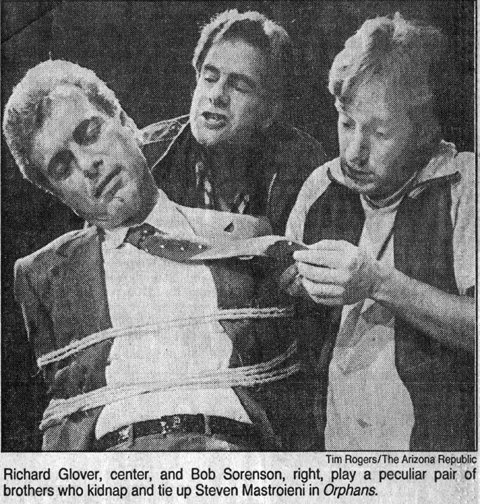
*****
NOTABLE CREDITS
This list is under construction.
More detailed descriptions of the plays can be found on the companies’ pages.
- 2012. The Unexpected Man. Theatre Artists Studio. Named one of 10 best plays of 2012 by the Arizona Republic.
- 2007 (?). Catastrophe.The Beckett Project – Nothing to be Done, Theatre Artists Studio. Directator.
- 2003. A Certain Release. Jeff MacMahon Projects, ASU. Narrator.
- 1998. Outcry. In Mixed Company. Felice.
- 1995. Exit the King. In Mixed Company. King Beringer I. Awarded the New Times Best Production of 1995. Steve won the Tribune Newspapers’ Maxie Award for Best Actor in a Drama.
- 1994. The Adding Machine. ASU Drama City. Mr. Zero.
- 1993. Little Murders. In Mixed Company.
- 1991 (?). Edmund. ASU Showcase Theatre.
- 1987. Orphans. Actors Theatre of Phoenix. Directed by Judy Rollings. Hal, the gangster. Steve won the Tribune Newspapers’ Maxie Award for Best Actor in a Drama.
- 1984. Nightwatch. Phoenix Little Theatre.
- 1984. Cloud Nine. Phoenix Little Theatre.
- 1983. Deathtrap. Scottsdale Community Players, Stagebrush Theatre.
- 1983. Getting Out. Scottsdale Community Players, Stagebrush Theatre.
- 1982. Private Lives. Phoenix Little Theatre.
- 1981. The Night of the Iguana. Phoenix Little Theatre. Reverend Dr. T. Lawrence Shannon.
- 1981. Whose Life Is It Anyway? Phoenix Little Theatre. Ken Harrison.
- 1979. Ashes. ASU Theatre.
- 1979. Anne of a Thousand Days. Phoenix Little Theatre.
- 1976. A Midsummer Night’s Dream. Southwest Ensemble Theatre.
- 1975. Imaginary Invalid. Southwest Ensemble Theatre.
- 1973. Seven Parables of Barsissaie Abed: Experimental Theatre Group
Kargahe Namayesh, Tehran Iran (World Premiere) – Rome, Italy - 1979. No Exit. Phoenix Little Theatre, Theatre One. Directed by Ruth Willis.
- 1978. The Boys in the Band. Scottsdale Community Players. Directed by Hope Silvestri. Harold.
- 1976. The Lion in Winter. Southwest Ensemble Theatre. Geoffrey.
- 1970. The Lion in Winter. Phoenix Little Theatre. Geoffrey.
- 1969. Wait Until Dark. Phoenix Little Theatre. Roat.
- FILM: 1986. Desert Bloom. Nick. Costars included Jon Voight, JoBeth Williams and Ellen Barkin.
- TELEVISION: Mafia Marriage, The Lieutenant, CBS Mini Series. Shattered Innocence, Andre, CBS Movie of the Week.
OTHER CREDITS
We Won’t Pay, We Won’t Pay (Giovanni) Drama City A.S.U. (Guest Artist)
Hot House (Lush) Drama City – A.S. U. ( Guest Artist)
Romeo & Juliet (Prince & Prologue) Phoenix Theatre
Accomplice (Derek-Hal) – Actors Theater Phoenix
The Relapse (Lord Foppington) A.S.U. – Guest Artist
A Delicate Balance (Tobias) – In Mixed Company
Marriage Play (Jack)- Theatre Artists Studio